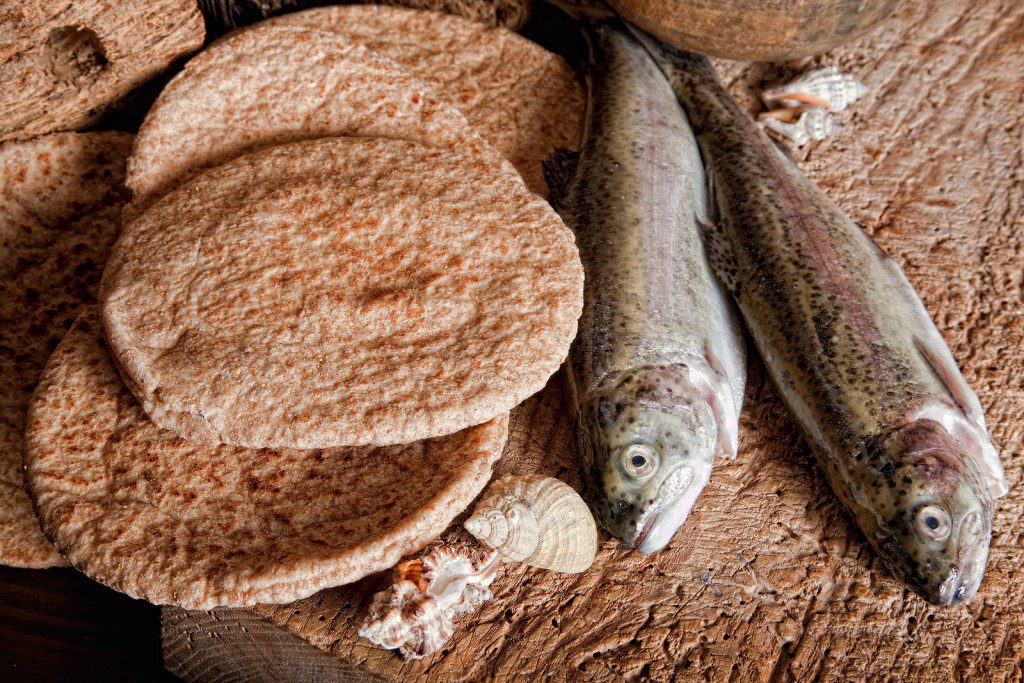
The First Communion
We’ve heard the story of Jesus feeding the multitude many times which isn’t surprising since the miraculous meal clearly occupied a central place in the oral tradition about Jesus. It is the only miracle story found in all four gospels (Matthew and Mark actually tell the story twice).
Interestingly, John (the last gospel to be written) is the only gospel with a small boy in the story. In every other account, the disciples seem to already have the bread and fish. So, it begs the question: why add the boy?
Given that John is well known as the most symbolic gospel, it makes sense that the boy represents someone or something. At the beginning of John’s gospel it says that people who came to believe that Jesus was the “true light” or the “Word become flesh” (that a divine presence was experienced in Jesus) were given the power to become “children of God.” Therefore, perhaps this boy a symbol of what it means to be a child of God, humble and generous?
While the gospel of John does not mention that “the last shall be first” or talk about the “least of these” or “becoming like a child to enter the kingdom of God,” still it is possible that he was influenced by the other gospels. Now the small boy, who held very little social value at the time, becomes a symbol of inclusion.
For me, this boy emphasizes and helps us remember that the meal shared that day was an inclusive meal. It highlights the interaction between Jesus and his disciples and one of the “least of these.”
Consider the crowd of 5,000 families for a moment. Who are these people? Are they all Jewish? Are they all wealthy? Are they all healthy? Are they all perfect people? Do they all believe the same things about Jesus? Are there doubters? Are there dissenters? Certainly this has to be a glorious mix of all of the above and more.
I'd invite us to look at this meal as an example of distributive justice in which everyone has their fill and no one is sent away.
On the bank of the Sea of Galilee, surrounded by a crowd of people who had followed him, Jesus turns to Philip and, already knowing the answer, asked, “Where can we buy bread for these folks?” Philip is stunned, “There is no way we could buy enough loaves even with 200 days’ wages!”
Andrew mentions that there is a boy with 5 loaves and two fish. Added together they are 7, the number of wholeness. It’s perfect! Jesus has his disciples help with the meal that is about to take place by getting the people to sit down. At which point Jesus does something that is familiar at every Sabbath meal and every Passover meal – he blesses bread, breaks it and shares it. Long before he and his disciples share the Passover meal the night before he dies, he uses the same ritual to share a meal with the masses. Surely this is the first communion.
Marcus Borg and John Dominic Crossan write, “[Jesus'] passion was the kingdom of God, what life would be like on earth if God were king, and the rulers, dominations systems, and empires of this world were not. It is the world that the prophets dreamed of – a world of distributive justice in which everybody has enough and systems are fair. And it is not simply a political dream. It is God’s dream, a dream that can only be realized by being grounded ever more deeply in the reality of God, whose heart is justice.”
God’s heart is justice, not judgment; inclusion, not exclusion.
Through the generosity of the child they experience a few moments when the kin-dom of God is manifest on earth through the very basic task of making sure everyone has enough to eat. Food for everyone equals justice.
Sadly, we too often live in a culture of scarcity (Philip saying we can’t afford that). We are afraid to share too much, lest we not have enough. And we live in a culture of privilege and exclusion (send them away to find something, we’ll just eat here with our little group).
Jesus, with the help of a small boy who seems to get it when the disciples don’t, started a different model. My question is: what on earth happened to it? In that very first communion, everyone was invited to the table, everyone was present for the blessing, everyone ate their fill. How did communion go from that first all-inclusive feast to a communion meal burdened with prerequisites, qualifications and expectations in so many churches?
The institutional Christian church has devised so many ways to keep people from the table. Even today in many denominations you must be a member of that church or that denomination, you must have attended the right classes, be old enough, be baptized, have gone to confession, or been confirmed. Many churches say you can't be divorced, or "living in sin" or LGBTQ, or be pro-choice. We didn't get this from Jesus!
It’s time to get rid of the communion police! If these judgments begin at Jesus’ table is it any wonder that they continue in personal attitudes and political agendas? If food is justice, it isn’t starting in the churches where it should start, and the attitude continues on in our streets and in our homes and in our schools and in out courtrooms. Some people are worthy and some aren’t. Baloney.
In this first communion that Jesus shared with the multitude, the most important thing is that everyone is welcome and everyone is fed, and there isn’t the overshadowing of Jesus’ death along with body and blood imagery that has distracted us from the radical nature of Jesus’ eating habits!
The table is set, the feast is prepared, will you come?
Love & Light!
Kaye



